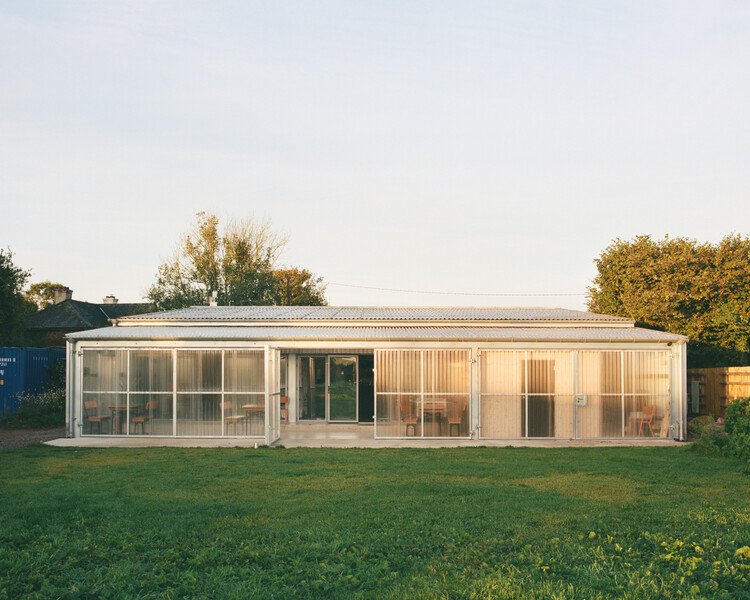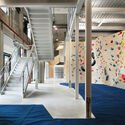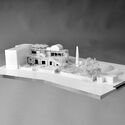
Selected by ArchDaily as one of the Best New Practices of 2024, IDK is injecting a fresh and dynamic approach to building communities with quality architecture. Mike Lim, James Pockson and Roddy Bow met while studying for their Masters in Architecture at the Royal College of Art (RCA) and founded their architecture practice, IDK, in London in 2019. The three, driven by a strong missionto help progressive communities and institutions, organizations and cultures thrive – have researched and delivered community-driven projects that incorporate experimental construction with a holistic approach. Their work focuses on nurturing social development, with an emphasis on ecological awareness, use of local materials, smart resource and budget management, respectful renovations, and designing only what is needed without “overbuilding.”






The studio operates much like they do with how they approach all of their projects — through constant collaboration. With a core team of seven members, IDK also brings in a number of experts to work with them on each project. Key to IDK’s ethos is that we don’t have all the answers all the time. We think there’s power in acknowledging this, as it pushes us to be open and collaborative in a way that enriches the work. In addition to its built projects, which range from small interventions and local exhibitions to mid-sized renovations and developments, IDK has several research works and unbuilt projects that also reflect its unique approach to placemaking: collective and participatory thinking that unites communities in need of specific programs, resulting in honest, responsible and often playful architecture.
We depend a lot on each other and this baseline is essential to be able to build together. We also want to enjoy what we do and, dare we say, have fun. It’s something special, being able to share that with each other.
Related article
The (ab)Normal Vision: Uniting Disciplines to Redefine Contemporary Design


In conversation with ArchDaily, the IDK team expands on the idea of social development through architecture, building for and with communities, and their methods and approaches to creating meaningful spaces.

(PP) When did your journey of building community through architecture begin? Can you point to a specific project that marked that beginning?
(IDK) We saw community building and architecture as fundamentally the same thing from the beginning. We all came to IDK with a strong sense of social responsibility, and ultimately our work is in service to the communities, audiences, and clients our projects support. It was important to us from the beginning that we were building IDK to deliver work with social value and purpose.
Seeing the overwhelmingly positive effect our Outside project has had on the community since it opened definitely felt big, but there wasn’t really one single project or moment. What we find important has evolved as we’ve learned how our work, processes, and results can have a real impact.
(PP) Your works are places that bring together local diversity and include varied programs. Can you describe your design process from the conception of a project? What are your sources of inspiration?
(IDK) We like our work to make sense. We are analytical and pragmatic, which comes from our backgrounds and the practices we work for, and we share a strong belief in value and economics as drivers of design. The first thing we do when we receive a brief is to question it. By breaking down the brief into detail, we are able to look for creative or innovative value-based solutions. If we can help our clients understand that there may be routes to achieving their goals that don’t require high-cost, high-risk, carbon-intensive new construction, we see that as a huge positive. It’s important that when we make the case for new construction, we can actually make the case for it.
A big part of our process is engaging and talking to the user groups, audiences, and communities that actively shape any project. We invest heavily in early conversations to really try to understand the needs, ambitions (and tensions) of a project. Once we have that clarity, we place a strong emphasis on simplicity and straightforward design. While we don’t believe in over-engineering a solution, we work hard to test options and iterate. Oftentimes, this brings us back to the simplest starting point, but we feel a responsibility to thoroughly question our own ideas before we launch them.
Another big part of our process is data-driven. We are committed to using measurement and data collection as tools to inform ongoing design processes – particularly with our retrofit projects which are often delivered in phases. We are very fortunate to work with Structure Workshop who have developed their own full lifecycle carbon calculator, which provides us with empirical carbon data throughout the design phases of a project. All of this allows us to be accountable and accurate with our proposals and with our clients’ budgets and assets.

(PP) Most of your projects involve collaboration with different groups and organizations. Do you have a “guide” or framework that helps you navigate these workflows? How do you approach these collaborations?
(IDK) We believe in genuine collaboration and partnership and aim to be very open and transparent. As individuals within the practice, we know what our own skills are and we rely on each other to complement, support and drive our work as a collective. The same applies to the groups, teams, individuals, experts, manufacturers, consultants, researchers, creators and suppliers we work with.
We’ve all been in a stressful construction environment and we know that it’s not good for our work, so we aim to empower our teams to create ownership and pride in what we do and create. As every project is unique and every team has its own distinct makeup, it’s important to be agile in our own ways of working. We’re constantly learning from our experiences.

(PP) The choice of materials in your projects reflects an awareness of environmentally responsible and respectful construction. What guides your decisions regarding materiality, local resources and material reuse?
(IDK) We believe that sustainability is as much a socioeconomic issue as it is a physical and environmental concern: it naturally extends to supporting local economies, using local labor and supply chains, and building strong, resilient communities that can sustain themselves and each other.
Outside Devon is a great example of this, as is our proposal for a low-carbon warehouse structure, which resulted in us simply recommending that our client buy a second-hand steel structure from eBay 20 miles away. Work like this highlights the importance of thinking and designing for maintenance, longevity, deconstruction and future reuse. We find that these critical factors are sometimes overlooked in favour of a knee-jerk leap to trendy natural building materials, but we think it’s essential to look further afield.


(PP) How does the Outside Project, built with community collaboration and offering multiple programs, demonstrate a successful approach to sustainable and local development in the area?
(IDK) One of the key things with Outside was our relationship with the community and the client. The team involved had all grown up in the area and had an existing connection with the place and the people around it. This connection meant that from the outset we had a genuine foundation of understanding to build on, and allowed us to develop a distinctive programme of the kind that we all feel is lacking in rural contexts like this.
Building the community of supporters and collaborators was essential to proving the need for the project. It helped support the case through planning and set it on a solid foundation to move forward. The network helped build the project, source materials and expertise through local supply chains, and created space for genuine dialogue and collaboration through its design and construction.
The Outside Project is a work in progress, and its growing network continues this incremental, collaborative approach to design and build – one that empowers the client while welcoming even more people to become a part of it. Having been open for two years, it’s really interesting to see what things have worked and what hasn’t on the site, as well as the project’s ability to change and evolve in response to the community around it.

#Creating #Communities #Architecture #IDKs #Collaborative #Design #Practice